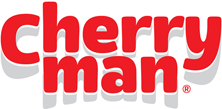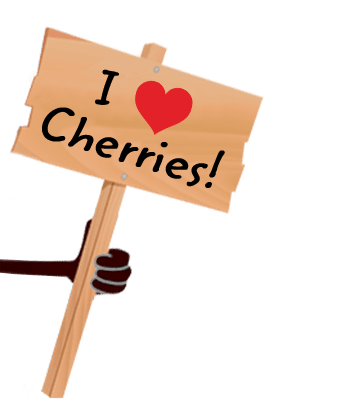Hey- thanks for asking. Here are the answers to all of your burning questions about my dee-lish maraschino cherries.
Where do maraschino cherries come from?
Well, my great, great, great grandfather came from Croatia as a descendent of the marasca cherry. Fast forward a few decades, and a few formulation tweaks later (thank you Mr. Wiegand), the modern maraschino comes from light sweet cherries such as the Royal Ann, Rainier or Emperor Francis varieties. These cherries actually have a yellow skin color with a red blush. However, maraschinos can be made from most varieties of sweet cherries, but not from sour or tart cherries (the kind used for cherry pie). Most U.S. light sweet cherries are cultivated in the Pacific Northwest and Michigan- two of the prettiest places on Earth, if you ask me. For a longer history lesson, Wikipedia's entry gets high marks for accuracy!
So can you pick maraschino cherries straight from the trees?
All CherryMan cherries are made in the USA from cherries grown in the USA, and I’m super proud of that.
There is a magical harvest/brine/pit/rinse/infuse/pack/pasteurize process that has to happen to make CherryMan maraschinos. Check out this nifty "What is a maraschino cherry?" video narrated by my friend Josh Reynolds (Gray & Company's president) to learn more about the process.
Where do they get their red color?
Smart question! My traditional maraschinos derive their bright red color from Red Dye #40, which has been proven safe by the FDA for food coloring usage. It is in thousands of products from beverages to soap to candy.
Why all the hype, you ask? In the early 1980s, red food dye received some negative attention as a possible carcinogen. The coloring in question was FD&C Red #3, not Red #40. The scientific evidence was inconclusive, and the FDA never placed a ban on Red #3. Some food companies switched to Red #40 just to avoid the issue, but this was not a concern at Gray & Company as we had been using Red #40 in the US all along. Country regulations outside of the United States vary greatly.
What is the shelf life of my jar of maraschino cherries?
Pretty darn long, because all CherryMan cherries are pasteurized and vacuum sealed.
Traditional CherryMan Cherries
OPENED: Once opened and refrigerated, my traditional maraschinos (jumbos, toppers, etc.) are good for three months, but that probably won’t happen, because an open jar is an empty jar. It’s true!
UNOPENED GLASS: If it somehow gets pushed to the back of your cupboard, and you leave your vacuum-sealed, air tight glass jar unopened, the cherries will remain delicious for up to three years. Over time, light and an infinitesimally slow rate of oxygen transmission will spoil the flavor first, and then the fruit. Which is sad.
UNOPENED PET: It's pasteurized, so it has a nice long two year shelf life. But why wait so darn long to enjoy my cherries? Just open, enjoy, eat 'em all, and buy a replacement jar, FAST!
Do maraschino cherries need to be refrigerated?
Yes. More detail above. Refrigerate once opened and place on the center shelf in front of all other fridge contents. At eye level. Snack away!
What's so nifty about your spiffy new PET jar?
Lots of stuff, actually. It took my friends Gray & Company over a decade to master the R & D to make it happen. Not everyone pasteurizes their cherries, but my friends at Gray & Company won't make 'em any other way. So that's an extra level of food safety you can trust.
And glass HURTS when you drop it on your foot, and makes a mess when it breaks on your kitchen floor. This one makes more of a gentle "thud" sound.
It's also BPA free, recyclable, and darn tootin' cute in its fun "sqround" shape. "Sqround" = square + round. Get it?
Are there allergens in your cherry products?
ALLERGEN STATEMENT:
Products made by Gray & Company do not contain any of the major food allergens as identified by the FDA. These include milk, egg and egg products, fish, crustacean shellfish (such as crab, lobster, or shrimp), tree nuts (such as almonds, pecans, or walnuts), wheat, peanuts, and soybeans. None of the major food allergens identified, or derivatives of them, are used or stored in the facility.
How about gluten?
The products produced by Gray & Company do not contain any ingredients that are derived from the following gluten-containing grains: wheat, barley, rye, oats, amaranth, teff, quinoa, spelt, triticale or millet.
Is there formaldehyde in my cherries?
This question makes CherryMan scratch his head. Formaldeh-WHAT? (Sounds like a high school biology experiment gone wrong.) No, my friend, this is one totally crazy urban myth. Maybe you'd find it sneaking into food made in other parts of the world, but not in the USA, and not in our factory. No way.
Are CherryMan maraschinos healthy?
Well, let's be clear: it IS candied fruit. But CherryMan believes in the mantra "moderation in all things." But he also believes that most things taste better with a cherry on top. If there is a place for sweets in your diet, CherryMan would be happy to be a part of it. CherryMan maraschinos are a tasty treat to enjoy as part of a balanced diet. They are fat-free, gluten-free, vegan, sodium free, kosher, and have just 2 grams of sugar per cherry. (That’s not very much. You'd have to eat twenty CherryMan cherries to equal the sugar in ONE can of cola.) So go ahead, top it off with a few cherries, but please don't skip the fresh fruit and veggies, and get some exercise every day. It feels good!
Does a maraschino cherry stay in your stomach for seven years?
Uhm, no. That’s another one of those weird urban myths you don’t need to worry about any more. You digest maraschinos just as you would any other fruit or candy.
How do you pronounce “Maraschino”?
To-may-to, To-mah-to. It's all in the em-pha-sis. "Mara-sheeno or Mara-skeeno"…both work!

